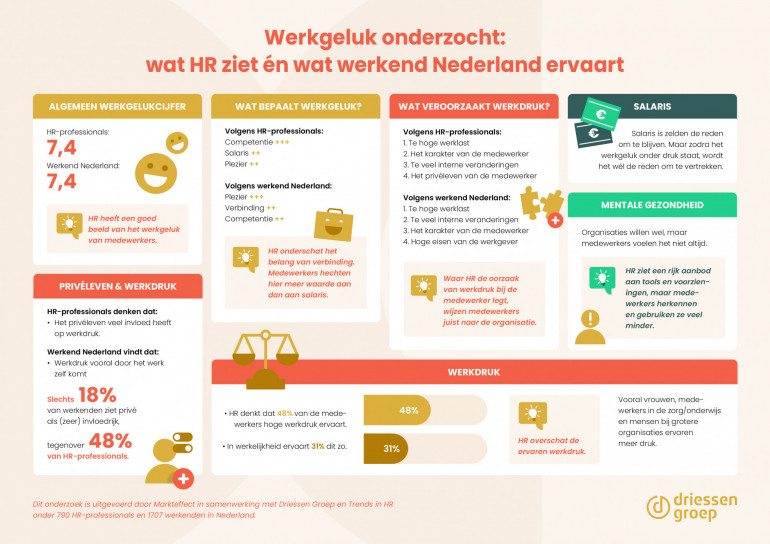Work happiness and work pressure: what HR sees and what working people experience
What determines whether a person enjoys working? And where does work pressure come from? In collaboration with the online platform Trends in HR and research agency Markteffect, we investigated how HR professionals think employees experience happiness at work and work pressure. And how working people in the Netherlands see this themselves. You can find the most important insights in the infographic. In this article we elaborate on them.

Same grade, different perception
Both HR and working Holland give job happiness a 7.4. That seems like they're on the same page, but if you look at what's behind that, you'll see distinct differences.
HR professionals think that happiness at work is mainly determined by competence, salary and fun. Working Netherlands itself mentions pleasure, connection and only then competence. The difference in the importance of connection is particularly striking. HR often focuses on conditions and structures, while employees derive their job happiness from how they feel in the workplace. Am I being seen? Do I belong? That, for many people, is where the core lies. It is a determining factor for happiness at work, more than salary is, and therefore deserves attention in HR policy.

Click on the image to enlarge it
Work Pressure: A Difference in Perspective
HR often overestimate perceived workload. HR thinks that work pressure is mainly caused by an excessive workload, the character of the employee, many internal changes and the employee's private life. Working people in the Netherlands look at this partly differently. Employees more often blame the organization itself, especially the high demands of the employer, and less their own private lives.
In some areas, HR and employees agree, but they often name the cause differently. Workload is not just about how much work there is, but how organizations handle change, expectations and support. HR wants to get it right, but employees don't always feel that way. That requires more than commitment. It requires alignment.
Work pressure is not the same for everyone
The numbers also show that work pressure is not the same for everyone. Women experience work pressure more often than men. The same goes for employees in education, care and for people working in larger organizations. Especially there, the pressure from outside is often already high. That's why a one-size-fits-all approach doesn't work either and customization is important.
Salary: increasingly important, but not decisive
Salary is still often mentioned by HR as an important factor for job happiness. And indeed: its importance is increasing, especially in times of economic uncertainty and staff shortages. But the research also shows that other factors weigh more heavily in how people actually experience their work. Think pleasure, connection and a sense of competence. Precisely because salary is not the main driver behind job happiness, HR professionals are less likely to see it as their biggest challenge. But that doesn't make it any less relevant. Especially when happiness at work is under pressure, salary can play a bigger role.
Good facilities, but often unused
Many organizations offer schemes to enhance happiness at work and mental health. Think coaching, training or vitality programs. Yet employees far from always recognize these opportunities. They do not know they are there or do not feel they can make use of them. So the offer is there, but does not always match what people need. There are gains to be made there.
Bring policy and perception closer together
What this research shows above all: HR and working Holland are closer together than they sometimes think. But don't always speak the same language. HR looks more at systems and structures, employees at their daily work. That difference does not have to remain significant. By listening well and tuning in, organizations can ensure that policy actually does something on the shop floor.
Do you want to talk more about job satisfaction in your organization? We'd love to think with you!
